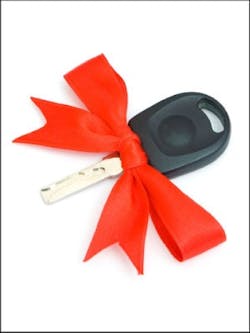Charitable donations build trust, brand awareness and a positive image for shops, which can ultimately build the bottom line. Refurbishing and donating vehicles for families in need is one way to do that. There are national organizations that spearhead such efforts, including the National Auto Body Council (NABC), but independent shops can benefit from doing it on their own.
Valerie White, co-owner and director of marketing at White Auto Body, says it takes time and careful planning to implement a vehicle donation effort. She shares her step-by-step process, and why it’s all worth it.
White Auto Body launched a program called White Christmas. We refurbish and donate three automobiles to community members in need of reliable transportation every December. One vehicle is donated from each of our three shop locations. A total of 29 vehicles have been gifted since the program launched in 1999.
This is a charitable effort, and that’s our main purpose of doing it. But what goes around comes around. It’s certainly a public relations activity, and you do get more business as a result. Following press release_notess we’ve put together, we have had several major TV stations and newspapers cover the program. We’ve received a lot of positive recognition, and good PR is an invaluable benefit. It has improved the image of our shop and brand.
Many shop operators see this type of program as an intimidating process to take on. It is a big project—planning and executing the effort takes about five months from August through December. But every shop can do it, and most already have resources at their fingertips to do it affordably.
We start accepting applications for vehicle recipients in August. Applications are available through October through an online process housed on the shop’s website. It’s a three-page application that includes background information about the nominee, and a narrative that explains why having reliable transportation would improve their life.
Anybody in the community can apply for the vehicle donation, either for themselves or on behalf of somebody they know. We don’t work directly with any nonprofit organizations to identify vehicle recipients, although I do contact several social service agencies and churches to foster nominations.
Applicants must fulfill certain criteria in order to be considered for the donation. They must have a valid driver’s license in the state, be insurable, have ability to insure the vehicle long-term, and have a demonstrable need for transportation. Our target demographic tends to be single parents who need a vehicle to obtain or retain employment.
We look for vehicles to acquire once the application process has started. Insurance companies typically donate the vehicles, ones that have been wrecked and deemed as total losses. There aren’t usually any costs associated with that.
Acquiring the right vehicle can be difficult. A lot of totaled cars come through the shop, but they aren’t always good candidates for the program. You have to find a car that doesn’t require a huge amount of restoration and labor, and that has been well maintained so you can be confident it will last. The cars we select are often totaled by the insurance company due to high mileage rather than severe damage. We won’t refurbish any significant wrecks because of the time required
The refurbishing process starts in November after the application deadline expires. It typically takes technicians two to three weeks to restore the vehicle. And there aren’t any costs associated with the repair. Our technicians donate their time after business hours and on weekends to make the repair. Our paint company supplies the refinishing products, and our parts vendors donate the parts needed.
The vehicle donation shouldn’t cause any immediate burden on the recipient, so we offer a few other things in addition to the car itself. We fill the car with gas, pay for six months of liability insurance, and cover costs associated with tax, titling and licensing requirements. That way the recipient can use the vehicle right away. Those things cost about $500 per vehicle. And then we plan a presentation event at the shop in mid-December.



